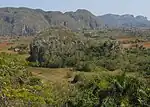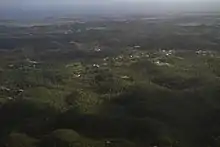
A mogote (/məˈɡoʊti/)[1] is a generally-isolated steep-sided residual hill in the tropics composed of either limestone, marble, or dolomite. Mogotes are surrounded by nearly flat alluvial plains. The hills typically have a rounded, tower-like form.
Overview
This term is used for hills, isolated or linked, with very steep, almost vertical, walls, surrounded by alluvial plains in the tropics, regardless of whether the carbonate strata in which they have formed are folded or not.[2][3]
Mogotes are common in tropical and subtropical karst areas around the world, which is that of southern China, the Southeast Asian countries of Indonesia, Laos, Malaysia, Myanmar, the Philippines, Thailand, and Vietnam; as well as the Caribbean, especially in Cuba and Puerto Rico. Los Haitises National Park in the Dominican Republic is another karst area that contains mogotes.[4]
The word mogote comes from the Basque word 'mokoti' meaning "sharp-pointed" ('moko' meaning "mountain peak").[5] In Puerto Rico, several mogotes along a ridge are called pepinos.[6]
Gallery
 Mogotes in Puerto Rico rising out of pineapple fields in a plain of blanket sand near Coto Sur. The quarry in the left background is 1 kilometer east of Manati.
Mogotes in Puerto Rico rising out of pineapple fields in a plain of blanket sand near Coto Sur. The quarry in the left background is 1 kilometer east of Manati. Two mogotes showing their typical rounded shape in Viñales Valley in Pinar del Río Province, western Cuba
Two mogotes showing their typical rounded shape in Viñales Valley in Pinar del Río Province, western Cuba Mogotes, Northern Matanzas Province, near the city of Cárdenas, Cuba
Mogotes, Northern Matanzas Province, near the city of Cárdenas, Cuba Mogotes in Northern Cuba, between Matanzas and Havana Provinces
Mogotes in Northern Cuba, between Matanzas and Havana Provinces View of mogotes along the Northern karst zone of Puerto Rico.
View of mogotes along the Northern karst zone of Puerto Rico. Mogotes in Sector Hess in Esperanza, Arecibo, Puerto Rico.
Mogotes in Sector Hess in Esperanza, Arecibo, Puerto Rico. Fengcongs and fenglins in Guilin, Guangxi, southeastern China, part of the South China Karst region.
Fengcongs and fenglins in Guilin, Guangxi, southeastern China, part of the South China Karst region. Aerial view of the Chocolate Hills, Bohol, Philippines, exhibiting both mogotes and cockpit karst characteristics.
Aerial view of the Chocolate Hills, Bohol, Philippines, exhibiting both mogotes and cockpit karst characteristics..jpg.webp)
 Mogotes, Krabi Province, southern Thailand.
Mogotes, Krabi Province, southern Thailand. Islets of mogotes in Ha Long Bay, Vietnam.
Islets of mogotes in Ha Long Bay, Vietnam.
See also
- Areas
References
- ↑ "mogote - Definition of mogote in English by Oxford Dictionaries". Oxford Dictionaries - English. Archived from the original on December 1, 2017.
- ↑ Neuendorf, K. K. E., J. P. Mehl, Jr., and J. A. Jackson, 2005, Glossary of Geology, 5th ed. American Geological Institute, Alexandria, Virginia. 779 p. ISBN 0-922152-76-4
- ↑ U.S. Environmental Protection Agency, 2002, A Lexicon of Cave and Karst Terminology with Special Reference to Environmental Karst Hydrology (2002 Edition). U.S. Environmental Protection Agency, Office of Research and Development, National Center for Environmental Assessment, Washington Office, Washington, D.C., EPA/600/R-02/003. 221 p.
- ↑ Uriarte, M.; Rivera, L.W.; Zimmerman, J.K.; Aide, T.M.; Power, A.G.; Flecker, A.S. (2004). "Effects of land use history on hurricane damage and recovery in a neotropical forest". Plant Ecology. 174: 49–58. doi:10.1023/B:VEGE.0000046058.00019.d9. S2CID 14918767.
- ↑ ASALE, RAE-; RAE. "mogote | Diccionario de la lengua española". «Diccionario de la lengua española» - Edición del Tricentenario (in Spanish). Retrieved 2021-09-19.
- ↑ BALGHIN, W. G. V.; COLEMAN, A. (5 March 1965). "Puerto Rico". Geography. 50 (3): 274–286. JSTOR 40567047.
Further reading
- Day, M.J. (March 1978). "Morphology and distribution of residual limestone hills (mogotes) in the karst of northern Puerto Rico". Geological Society of America Bulletin. 89 (3): 426–32. doi:10.1130/0016-7606(1978)89<426:madorl>2.0.co;2.